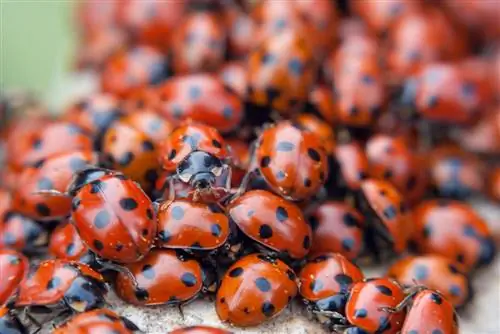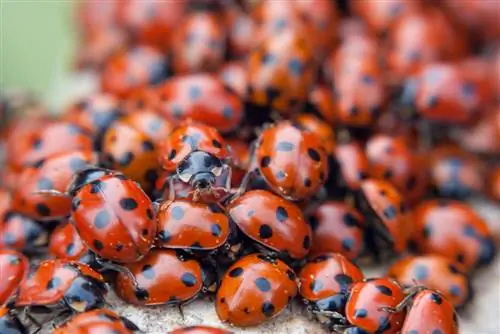- Author admin [email protected].
- Public 2023-12-16 16:46.
- Last modified 2025-01-23 11:22.
Do you want to grow your own ladybird colony for your garden or are you simply interested in closely observing the development stages of the little lucky beetle? Just come fresh! Because you can build your own vivarium with simple means.

How can I breed ladybugs myself?
To successfully breed ladybugs, you need a glass vivarium with insect protection net, crepe paper, louse-infested plants and ladybugs or larvae. Beetle care includes daily moistening and feeding with aphids and honey.
Good arguments for the targeted rearing of ladybugs
Breeding ladybugs yourself obviously has horticultural advantages. After all, the friendly fellows are hard-working pest killers and can effectively decimate aphids in particular. On the other hand, it is also exciting to follow the development of the beetle from egg to adult imago up close. Such a project can awaken dormant biological interest, especially in children.
Your own ladybug breeding
Various ready-made breeding sets for raising ladybugs (€47.00 on Amazon) including additional material for documentation and playful implementation are offered on the Internet. You can also easily set up your vivarium yourself. You don't need much:
- A large, approximately one liter glass jar
- A piece of insect protection net
- A rubber band
- 1-2 pieces of crepe paper
- Plants infected with aphids
- And of course ladybugs
1. Preparing the vivarium
First, prepare the glass as a small, species-appropriate oasis for your developing ladybird colony. This has to happen in the spring, around April. To do this, first line the glass base with crepe paper folded several times. It is intended to hold moisture in small amounts, similar to cress seeds on the windowsill.
2. Equip vivarium
Then go outside and look for the first aphid-infested plants. The lice initially reproduce asexually in spring and are very productive. You may also find aphids or scale insects on your houseplants.
At the same time, keep an eye out for ladybugs. You have a good chance of discovering them by searching through dense bushes, piles of leaves or nettle tuff. The animals like to stay in such sheltered places after overwintering. Of course, you need a bit of luck to catch males and females. Unfortunately, they don't look much different from the outside.
Alternatively, later in the year, around mid-May, you can also collect ladybird larvae from the undersides of leaves and trunks. The spectacle of mating is of course withheld from you.
Carefully collect lice-covered plant stems and leaves and the ladybirds and place them in the jar.
3. Seal and care for air permeability
After loading, close the jar with the piece of insect gauze and secure it with the rubber band. Place it in a warm place protected from direct sun. For care, the vivarium must be moistened daily with a water disperser. Also make sure that the ladybirds always get a supply of plant parts infected with aphids or scale insects and also some honey.
4. Watch
Now you can track the development of your own lucky charms. After mating, the female will hopefully lay eggs on the leaves of the plants in the vivarium. The larvae hatch after about 5-8 days. Now you have to ensure an increased supply of aphids so that the larvae don't eat each other. It takes another 1-2 months until pupation. The finished beetles then hatch with their species-specific coloring! Now you can put them out and enjoy their gardening help or simply their friendly, lovely company.






